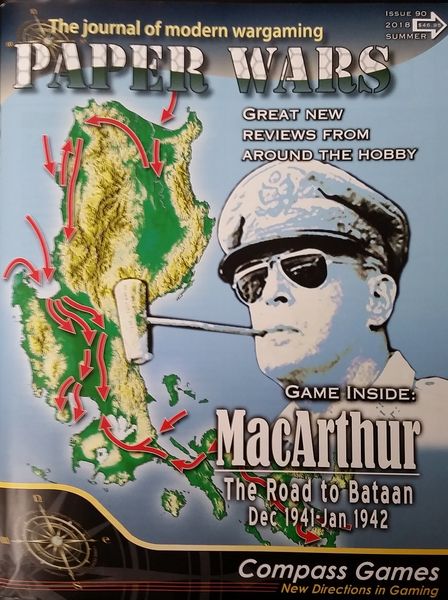MacArthur: The Road to Bataan, Dec 1941 – Jan 1942 (1985) Board Game
Brief History and Background Information for MacArthur: The Road to Bataan, Dec 1941 – Jan 1942
MacArthur: The Road to Bataan is a historical wargame that focuses on the events that took place during the early stages of World War II in the Pacific theater. The game covers the period from December 1941 to January 1942, a crucial time for General Douglas MacArthur and his forces as they faced the Japanese invasion in the Philippines.
Game Components of MacArthur: The Road to Bataan, Dec 1941 – Jan 1942
- Map of the Philippines
- Military unit counters
- Combat dice
- Strategy cards
How To Setup MacArthur: The Road to Bataan, Dec 1941 – Jan 1942
- Place the map of the Philippines on the table.
- Each player chooses a side to play as, either the American or Japanese forces.
- Place the military unit counters on their designated starting locations.
- Shuffle the strategy cards and place them within reach of both players.
- Roll to determine who goes first.
Gameplay Mechanics and Game Objective
Players take turns moving their military units, engaging in combat, and using strategy cards to gain an advantage. The objective of the game is to either defend the Philippines as the American forces or conquer it as the Japanese forces.
Player Experience
Pros
- Detailed historical accuracy in the game design.
- Strategic depth with the use of cards and combat mechanics.
- Immersive gameplay experience that captures the tension of the historical events.
Cons
- Steep learning curve for new players.
- Limited replay value due to the specific historical setting.
- Requires dedicated 2-player setup, may not be suitable for solo play.
Personal Thoughts on MacArthur: The Road to Bataan, Dec 1941 – Jan 1942
MacArthur: The Road to Bataan offers a unique and immersive experience for players interested in World War II history and strategic wargames. The game’s attention to detail and historical accuracy make it a compelling choice for enthusiasts looking to recreate the events of the early Pacific theater battles.
While the game may not appeal to casual gamers due to its complexity and niche historical theme, it is a worthwhile addition to any wargame enthusiast’s collection. The build quality is solid, and the components are well-designed, adding to the overall enjoyment of the gameplay experience.
In terms of pricing and availability, MacArthur: The Road to Bataan may be harder to find as it was released in in 1985. However, dedicated gamers may be able to source a copy through online marketplaces or specialty stores that carry vintage wargames.
Overall, I believe MacArthur: The Road to Bataan is worth the time and investment for players looking for a challenging and historically immersive wargame experience. It may not be suitable for everyone, but for those with a passion for military history and strategic gameplay, it is a game that should not be overlooked.
Game Components of MacArthur: The Road to Bataan, Dec 1941 – Jan 1942
How To Setup MacArthur: The Road to Bataan, Dec 1941 – Jan 1942
To set up the game, players must first lay out the map of Luzon Island and its surroundings. The Japanese player places their units at various potential invasion points around the island, while the Allied player sets up their defenses, particularly focusing on key locations like Manila Bay, Manila, and the fortress of Corregidor. Each player must adhere to the specific setup instructions for the chosen scenario, ensuring historical accuracy and strategic challenge.
Gameplay Mechanics and Game Objective
Player Experience
Playing **MacArthur: The Road to Bataan** immerses players in the strategic challenges of the early Pacific Theater during World War II. The game requires careful planning and resource management, as players must balance defense and offense in a dynamic and historically rich environment. The lack of significant external support for the Allies adds an layer of urgency and complexity, making each decision critical to the outcome.
Pros
Cons
Personal Thoughts on MacArthur: The Road to Bataan, Dec 1941 – Jan 1942
**MacArthur: The Road to Bataan** is ideal for wargaming enthusiasts and those interested in World War II history. It offers a challenging and immersive experience that requires strategic thinking and historical understanding. While it may not be the best fit for casual gamers due to its complexity, it is a gem for those who enjoy deep, historically grounded wargames.
We are supported by our audience. When you purchase through links on our site, we may earn an affiliate commission, at no extra cost for you. Learn more.

